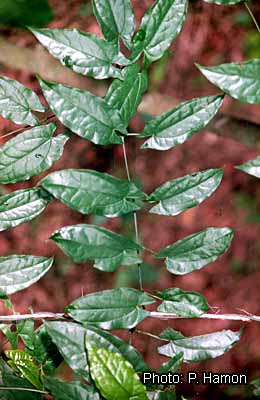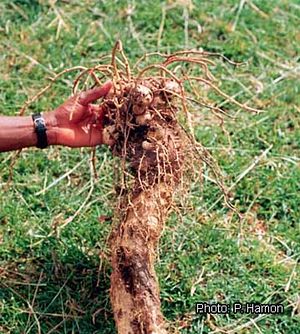Dioscorea praehensilis (PROTA)
Introduction |
| General importance | |
| Geographic coverage Africa | |
| Geographic coverage World | |
| Vegetable | |
| Carbohydrate / starch | |
| Medicinal | |
| Ornamental | |
| Food security | |
Dioscorea praehensilis Benth.
- Protologue: Hook., Niger Fl.: 536 (1849).
- Family: Dioscoreaceae
Synonyms
- Dioscorea cayenensis Lam. var. praehensilis (Benth.) A.Chev.
Vernacular names
- Bush yam, forest yam, white yam (En).
- Igname de brousse, igname sauvage (Fr).
Origin and geographic distribution
Dioscorea praehensilis occurs wild from Guinea east to Ethiopia and south to Angola, Zambia, Malawi and Mozambique.
Uses
The young shoots are eaten in Bas Congo (DR Congo). The flesh of the tuber is bitter and only eaten after careful preparation. In Gabon the tuber is only eaten when young and after long cooking. In northern Nigeria it is eaten as famine food. In Congo the boiled tuber is taken to accelerate childbirth, and sometimes to relieve rheumatism. In DR Congo an infusion prepared from the older stem is used to treat stomach complaints, urethral discharge and oedema.
Botany
- Dioecious climbing herb up to 15 m long; tuber up to 60 cm long, flesh white with yellow tinge, with bitter purple layer below the skin, armed with a crown of thorny roots; stem 1–2 cm in diameter, slightly ribbed longitudinally, spiny, often waxy, glabrous, purplish-green.
- Leaves opposite, occasionally alternate, simple; petiole 2.5–5 cm long; blade ovate to ovate-lanceolate, 4–10 cm × 3–5 cm, deeply cordate at base, acute at apex, entire, 5–7-veined; basal leaves often strongly reduced.
- Inflorescence an axillary spike; male ones 3–5 together, flexuous, 3–5 cm long; female ones 1–2 together, pendulous, 10–25 cm long.
- Flowers unisexual, perianth segments in 2 rows of 3, 1–1.5 mm long; male flowers with 6 stamens; female flowers with inferior, 3-celled ovary.
- Fruit a deeply 3-lobed capsule 2–2.5 cm × 3 cm, 3–6-seeded.
- Seeds winged all round, 1.5–2 cm long.
It has been suggested that Dioscorea praehensilis is one of the parents of the cultivated Dioscorea cayenensis Lam., together with other species of the section Enantiophyllum such as Dioscorea abyssinica Hochst. ex Kunth and Dioscorea burkilliana J.Miège.
Ecology
Dioscorea praehensilis grows in forest, often secondary forest, and along forest margins up to 700(–1600) m altitude.
Management
Dioscorea praehensilis has occasionally been taken into cultivation. The wild form has been to some extent genetically improved to produce longer tubers. In some cultivars the protective thorny armature of roots has been reduced to slender short spiny roots. The cultivation is like other yams; Dioscorea praehensilis is grown in well-weeded plots, often in mounds of soil and trained against a support.
Genetic resources
Dioscorea praehensilis is quite common in West Africa. It is considered one of the wild relatives, or even one of the parents, of the cultivated Dioscorea cayenensis and therefore may be used as a source of resistance and other useful properties. The many genetically different populations are being studied.
Several living collections are kept in institutes in Ghana, Côte d’Ivoire, Togo, Benin and Nigeria. The seeds of Dioscorea praehensilis can be stored under gene bank conditions for long periods without deterioration. Dioscorea seed collections are kept in gene banks all over the world; large collections are maintained at IRD (Institut de Recherche pour le Développement), Montpellier, France and IITA, Ibadan, Nigeria.
Prospects
As a vegetable Dioscorea praehensilis is of limited use and potential. It is important as a source of genetic variation in yam breeding work. Further genetic improvement to reduce the bitter constituents may render this yam more palatable and popular.
Major references
- Bouquet, A., 1969. Féticheurs et médecines traditionnelles du Congo (Brazzaville). Mémoires ORSTOM No 36. Office de la Recherche Scientifique et Technique Outre-Mer. Paris, France. 282 pp.
- Burkill, H.M., 1985. The useful plants of West Tropical Africa. 2nd Edition. Volume 1, Families A–D. Royal Botanic Gardens, Kew, Richmond, United Kingdom. 960 pp.
- Coursey, D.G., 1976. The origins and domestication of yams in Africa. In: Harlan, J.R., De Wet, J.M.J. & Stemmler, A.B.L. (Editors). Origins of African plant domestication. Mouton, the Hague, Netherlands. pp. 383–408.
- Dalziel, J.M., 1937. The useful plants of West Tropical Africa. Crown Agents for Overseas Governments and Administrations, London, United Kingdom. 612 pp.
- Latham, P., 2004. Useful plants of Bas-Congo province, Democratic Republic of the Congo. DFID, London, United Kingdom. 320 pp.
Other references
- Berthaud, J., Bousalem, M., Daïnou, O., Dubern, J., Malaurie, B. & Tostain, S., 1998. La domestication de l’igname et l’amélioration participative peuvent-elles être de nouvelles méthodes pour conserver les ressources génétiques de cette plante et répondre aux nouveaux besoins des agriculteurs? [Internet] Paper presented on the 7th Symposium of the International Society for Tropical Root Crops - Africa Branch (ISTRC-AB), October 11–17, 1998, Cotonou, Benin. http://www.bj.refer.org/benin_ct/rec/igname/berthaud.htm. 24 July 2003.
- IPGRI, 2003. Plant genetic resources in Sub-saharan Africa. Specific crops - Tubers. [Internet] http://www.ipgri.cgiar.org/regions/ssa/specificcrops/tubers.htm. 24 July 2003.
- Malaurie, B., Pungu, O. & Trouslot, M.F., 1995. Effect of growth regulators concentrations on morphological development of meristem-tips in Dioscorea cayenensis - D. rotundata complex and D. praehensilis. Plant Cell, Tissue and Organ Culture 41: 229–235.
- Miège, J. & Demissew Sebsebe, 1997. Dioscoreaceae. In: Edwards, S., Mesfin Tadesse, Demissew Sebsebe & Hedberg, I. (Editors). Flora of Ethiopia and Eritrea. Volume 6. Hydrocharitaceae to Arecaceae. The National Herbarium, Addis Ababa University, Addis Ababa, Ethiopia and Department of Systematic Botany, Uppsala University, Uppsala, Sweden. pp. 55–62.
- Okigbo, B.N., 1987. Roots and tubers in the African food crisis. In: Terry, E.R., Akoroda, M.O. & Arene, O.B. (Editors). Tropical Root Crops: Root crops and the African food crisis. Proceedings of 3rd triennial symposium of the International Society for Tropical Root Crops - Africa Branch (ISTRC-AB), August 17–23, 1986, Owerri, Nigeria. pp. 9–20.
- Okiy, G.E.O., 1962. Indigenous Nigerian food plants. Journal of the West African Science Association 6(2): 117–121.
- Ongoiba Moussa, H., 1985. Les plantes spontanées alimentaires utilisées en période de soudure et quelques uns de leurs usages domestiques et phytothérapeutiques traditionnels dans la deuxième région du Mali. Thèse (Doctorat), Université de Paris 6, Paris, France. 216 pp.
- Raponda-Walker, A. & Sillans, R., 1961. Les plantes utiles du Gabon. Paul Lechevalier, Paris, France. 614 pp.
- Tostain, S. & Daïnou, O., 1998. Bilan des collectes de Dioscorea abyssinica et de D. praehensilis, en 1996 et 1997; première étape d’un programme d’étude des relations entre ignames sauvages et ignames cultivées au Bénin. In: Berthaud, J., Bricas, N. & Marchand, J.L. (Editors). Actes du séminaire international CIRAD-INRA-ORSTOM-CORAF, 3–6 juin 1997, Montpellier, France. pp. 257–258.
Author(s)
- W.J. van der Burg, PROTA Network Office Europe, Wageningen University, P.O. Box 341, 6700 AH Wageningen, Netherlands
Correct citation of this article
van der Burg, W.J., 2004. Dioscorea praehensilis Benth. [Internet] Record from PROTA4U. Grubben, G.J.H. & Denton, O.A. (Editors). PROTA (Plant Resources of Tropical Africa / Ressources végétales de l’Afrique tropicale), Wageningen, Netherlands.
Accessed 22 December 2024.




